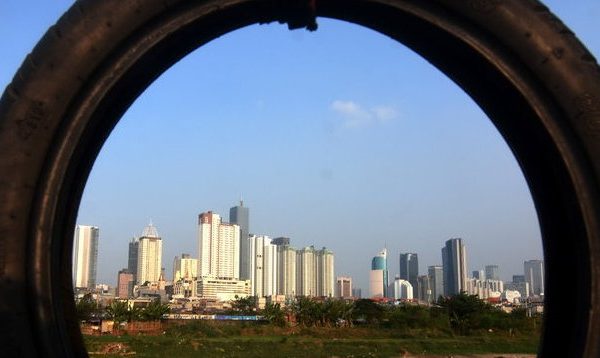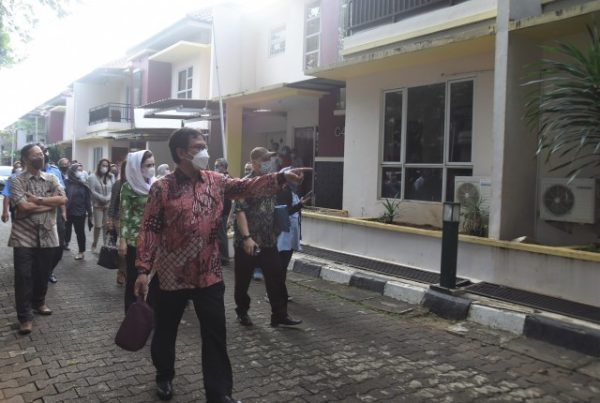(Civil Service) Budgetary Transfers to Regions
The 24/8 edition of Kompas carried an item on the effectiveness of increased State budget (APBN) fiscal transfers to regions of Rp 518.9 trillion—31.3% of total APBN expenditure— in 2013, much of which, according to Coordinating Minister of Economic Affairs Hatta Rajasa, would be absorbed by civil service costs.
Research conducted by the Indonesian Forum for Budget Transparency (FITRA) revealed that in 2011 124 regions allocated more than 50% of their budgets for civil service costs. In 2012 that number rose to 302: indeed, 16 regions allocated over 70% of their budgets to meet bureaucratic costs. Such patterns of budgetary spending make it difficult to achieve the fundamental aim of regional autonomy—now in place for more than a decade—viz., to enhance public welfare by bringing public service delivery closer to the people.
We have not arrived at this situation all of a sudden because of bad budget management on the part of regional governments: Flaws in the fiscal decentralization system and inconsistent central government behaviour have contributed to this state of affairs in which regional governments allocate more for the benefit of public service deliverers than on the actual delivery of public services.
It is well known that, on average, regions depend for 80% of their budget income on transfers from APBNs and that most of those transfers are in the form of funding for civil service costs. Thus, given that the basic component of the General Allocation Fund (DAU) is designed to cover regions’ civil service funding requirements, regions don’t think twice about recruiting and paying for additional civil servants. Indeed, the formula used to calculate DAU transfers lulls regions to sleep, as it were, and encourages them to propagate even more autonomous regions. If anything, the formula provides incentives to regions increasing civil service costs and disincentives for those that reduce them; after all, reducing such costs also reduces a region’s share of DAU allocations.
The bulk of regional fiscal transfers in State budget 2013 are to be directed at meeting civil service costs: Rp 306.2 trillion in the form of DAU transfers (59% of total transfers); Rp 43.1 trillion as professional allowances for teachers (8%); and Rp 2.4 trillion as additional income for teachers (1% of total transfers). Thus, in practice, regions can hardly be expected to lift the level of their 2013 budget allocations for capital expenditure or public service delivery.
Almost every year, when presenting its annual financial statement, the government claims that fiscal transfers to regions have continued their upward trend. But, in fact, from one year to the next such transfers continue to remain at around 31% of total APBN expenditure. Assuming an economic growth rate of 6.8% and inflation of 4.9%, an 8.4% increase in the level of fiscal transfers to regions does not amount to a significant change in real terms.
The principle “money follows functions” is being turned on it head in the case of fiscal transfers to regions: regions are responsible for 31 government functions—amounting to 70% of total government business—but budgetary resources transferred to regions only amount to around 30% of total APBN expenditure.
The government has also been inconsistent in its approach to redirecting funds advanced to regions for centrally delegated functions or tasks jointly administered by the Center and regions, by changing them into fiscal transfers to regional budgets for expenditure on functions that now amount to local government responsibilities. Law No. 33/2004 concerning Fiscal Balance Transfers from the Center to Regions—specifically Article 108 on transitional arrangements for the new law—clearly states that funding for delegated or jointly administered functions should be progressively brought under the umbrella of the Special Allocation Fund (DAK); it also directed that enabling legislation should be issued to effect that change. But Article 108 has not been seriously implemented: It took four years for the enabling legislation (Government Regulation No. 7/2008) to appear and, when it did, it still merely stated that the switch to the DAK should be made progressively. FITRA’s research in 2011 unearthed no evidence that funding for either delegated or co-administered functions was being switched to the DAK; on the contrary, both streams of funding have been trending upwards each year.
There has also been a lack of equity in the way the central government has been applying the DAU formula: This has resulted in a shortfall in DAU funding that regions should by right have been receiving. Article 27 of Law No. 33/2004 prescribes that overall DAU funding should be at least 26% of net domestic revenue; the law’s explanatory notes describe “net domestic revenue” as State revenue deriving from tax and non-tax sources less revenue shared with regions via the Revenue Sharing Fund (DBH). But, in fact, since 2008 the DAU funding pool has been reduced by deducting not only DBH funds but also subsidies and “earmarked” revenue.
In the 2013 State budget, for example, the government has subtracted the following from net domestic revenue for DAU purposes: components of non-tax revenue of ministries and agencies identified (“earmarked”) for re-use; taxation subsidies; and 60% of other subsidies. This has resulted in Rp 306.2 trillion being transferred to regions via the DAU in 2013 (p. 308 of Financial Statement accompanying draft 2013 APBN). But, if government faithfully adhered to the formula laid down in Law No. 33/2004, the figure should actually be Rp 390.8 trillion—Rp 84.6 trillion more than the budgeted amount. Regional governments and the House of Representatives should be able to pressure government to make good that difference to ensure provisions of law are met.
It is not appropriate that the central government simply blame regional governments for the shortcomings of the fiscal decentralization system and rest easy on its commitment to fostering fiscal decentralization, unless it modifies its own decentralization model and consistently implements its own fiscal decentralization policies.
Yuna Farhan
Secretary-General of FITRA/co-author of the Alternative APBN for 2013
prepared by the Civil Society Coalition for Welfare-Based APBNs
August 2012
THURSDAY, AUGUST 30, 2012
Transfer Anggaran (Birokrasi) Daerah
Kompas (24/08) hal 17 mengangkat berita soal efisiensi dana transfer yang meningkat pada Rancangan Anggaran Pendapatan dan Belanja Negara 2013, dengan alokasi mencapai Rp 518,9 triliun atau 31,3% dari total belanja. Menteri Koordinator Perekonomian Hatta Rajasa menambahkan, transfer daerah masih banyak tersedot untuk belanja pegawai.
Berdasarkan data FITRA, pada tahun 2011 terdapat 124 daerah yang 50% lebih anggarannya dialokasikan untuk belanja pegawai, jumlahnya meningkat menjadi 302 daerah pada APBD 2012, bahkan 16 daerah diantaranya menganggarkan belanja pegawainya di atas 70%. Dengan postur anggaran seperti ini, tujuan otonomi daerah untuk meningkatkan kesejahteraan rakyat daerah dengan mendekatkan pelayanan publik akan sulit dicapai, meski otonomi daerah telah berjalan lebih dari satu dasawarsa.
Fakta ini tidak secara serta merta ditujukan karena buruknya tata kelola anggaran di daerah. Kelemahan pada sistem desentralisasi fiskal dan tidak konsitennya Pemerintah Pusat memberikan kontribusi terhadap potret anggaran daerah yang lebih banyak dialokasikan untuk “ongkos tukang” dibandingkan pelayanan publik.
Seperti diketahui, rata-rata daerah menggantungkan 80% pendapatan daerahnya terhadap dana transfer dari APBN, sementara sebagian besar transfer daerah sudah dalam bentuk belanja pegawai. Dengan memperhitungkan kebutuhan belanja pegawai sebagai alokasi dana dasar pada Dana Alokasi Umum (DAU), otomatis daerah tidak ambil pusing untuk membiayai atau merekrut baru pegawainya. Formula DAU “me-nina bobokan” daerah untuk terus merekrut pegawai baru dan memekarkan diri. Formula DAU justru memberikan insentif terhadap membengkaknya belanja pegawai dan disinsentif bagi daerah yang efisien belanja pegawainya, karena tidak ingin jatah DAU-nya akan berkurang.
Dalam RAPBN 2013, sebagian besar transfer daerah dialokasikan untuk belanja pegawai, dalam bentuk DAU Rp 306,2 triliun (59%), tunjangan profesi guru Rp 43,1 triliun (8%) dan tambahan penghasilan guru Rp 2,4 triliun (1%). Praktis, sulit mengharapkan daerah untuk mengalokasikan lebih besar anggarannya untuk belanja modal atau pelayanan publik.
Hampir setiap tahun, dalam penyampaian pidato nota keuangan pemerintah selalu mengklaim, terus meningkatkan dana transfer daerah. Meski kenyataannya, dari tahun ke tahun proporsi dana transfer daerah tidak bergerak jauh dikisaran 31% dari total belanja negara. Secara nilai riil, dengan asumsi pertumbuhan ekonomi 6,8% dan inflasi 4,9%, pertumbuhan transfer daerah sebesar 8,4% tidak berarti penambahan yang signifikan.
Berdasarkan prinsip money follow function, transfer daerah justru berbanding terbalik dengan urusan yang didesentralisasikan. sebanyak 31 urusan pemerintah atau 70% urusan pemerintah di serahkan ke daerah, sementara dari segi proporsi anggaran yang ditransfer dikisaran 30%.
Pemerintah juga tidak konsisten untuk mengalihkan dana dekonsentrasi dan tugas pembantuan yang telah menjadi urusan daerah. Pasal 108 ketentuan peralihan pada UU No 33 tahun 2004 tentang Perimbangan Keuangan Pusat Daerah, secara tegas menyatakan dana dekonsentrasi dan tugas pembantuan secara bertahap dialihkan menjadi Dana Alokasi Khusus (DAK) dan diatur lebih lanjut dalam bentuk Peraturan Pemerintah (PP). Namun, ketentuan ini tidak sungguh-sungguh dilaksanakan. Dari segi mandat hukum, PP dana dekonsentrasi dan tugas pembantuan, baru dikeluarkan empat tahun kemudian melalui PP No 7 tahun 2008. Itupun, dalam PP ini masih dinyatakan dana dekonsentrasi dan tugas pembantuan dialihkan secara bertahap. Berdasarkan kajian FITRA (2011), tidak terlihat sama sekali dana dekonsentrasi dan tugas pembantuan dialihkan menjadi DAK. Trend kedua alokasi ini cenderung naik setiap tahunnya.
Pemerintah Pusat juga tidak fair dalam menggunakan rumus formula DAU, sehingga terjadi selisih kekurangan DAU yang seharusnya menjadi hak daerah. Merujuk pada pasal 27 UU No 33 tahun 2004, jumlah keseluruhan DAU ditetapkan sekurang-kurangnya 26% dari Perdapatan Dalam Negeri (PDN) Neto yang ditetapkan dalam APBN. Selanjutnya dalam penjelasan pasal ini dinyatakan PDN Neto adalah Penerimaan Negara yang berasal dari Pajak dan Bukan Pajak setelah dikurangi dengan penerimaan Negara yang dibagi hasilkan kepada daerah atau Dana Bagi Hasil. Pada prakteknya, alokasi DAU sejak tahun 2008 selalu lebih kecil dari ketentuan ini. Hal ini terjadi karena, faktor pengurang PDN Neto selalu bertambah, tidak hanya dana bagi hasil, melainkan juga subsidi dan pendapatan yang bersifat earmark.
Pada RAPBN 2013 misalnya, pemerintah menambah komponen Penerimaan Negara Bukan Pajak (PNBP) Kementerian/Lembaga yang akan digunakan kembali, subsidi pajak dan 60% subsidi lainnya, sebagai faktor pengurang dalam menetapkan PDN netto, dengan alokasi DAU menjadi Rp 306,2 triliun (Nota Keuangan RAPBN 2013, p.308). Padahal, jika pemerintah konsisten menggunakan formula DAU sesuai dengan UU Perimbangan Keuangan, maka DAU yang seharusnya dialokasikan pada RAPBN 2013 sebesar Rp 390,8 triliun atau terdapat selisih Rp 84,6 triliun dari DAU yang dialokasikan pada RAPBN 2013. Pemerintah Daerah atau DPR seharusnya bisa mendesak Pemerintah untuk meningkatkan alokasi DAU sesuai dengan rumusan yang diatur UU.
Tidak selayaknya, Pemerintah Pusat melempar kesalahan pada daerah semata, atas terjadinya inefisiensi dan inefektivitas transfer daerah, dan merasa terus berkomitmen meningkatkan desentralisasi fiskal, tanpa disertai perubahan disain desentralisasi fiskal yang dibuatnya sendiri dan konsisten menerapkan kebijakannya.
Yuna Farhan
Sekjen FITRA
http://cetak.kompas.com/read/2012/08/28/05051691/transfer.anggaran.birokrasi.daerah
Kompas, 28 Agustus 2012




